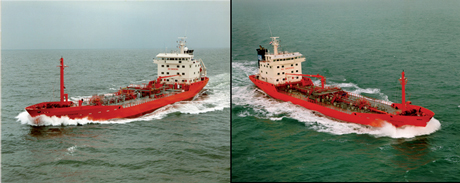Turbulent water flow reduces the efficiency of a ship's propeller. The propulsion system works best when the water is undisturbed, but that certainly isn't the case in a ship's wake. The stern of most ships is therefore designed to ensure a relatively regular flow pattern. The bow wave is also a key factor in energy consumption. Energy is expended in creating waves: a smaller bow wave therefore results in less energy loss.
Ship designers study these phenomena in order to design better ships. The ultimate goal is to calculate the ship geometry that will best meet the various demands placed on the vessel, not only in terms of fuel efficiency, but also with respect to stability, safety and logistical efficiency. To study the properties of ships, designers need software to simulate wave and wake patterns around the hull. However, the computation of such flow patterns tends to be a time-consuming process, because waves take a long time to dissipate. During simulation, the waves wash around in the computer for a long time before a steady wave pattern emerges. Numerous computational steps are required before a usable result is obtained. Moreover, the simulations must be repeated for different sailing conditions and ship speeds. Hence there is a need for computational methods that produce a steady wave pattern more quickly.
The Ever-Changing Surface
One of the principal barriers to fast computation is the surface of the water. Computations could be carried out much more quickly if the water surface were not a factor.
Jeroen Wackers and Barry Koren found an algorithm to quickly calculate the steady flow pattern without having to progress through each successive time phase. They explicitly factored in the air above the water surface. Air is a fluid with very low density. Several good algorithms exist to describe the interplay of two fluids, allowing rapid computation of a steady wave pattern in which all forces are in equilibrium. With air above it, the water surface no longer constitutes the boundary of the problem, it lies in the interior of the computational domain, and boundary conditions need not be specified for it. The entire simulation area water and air can be efficiently treated in the same manner.
Much Greater Speed
Using this two-fluid approach, flow of water and air in a canal was simulated. Irregularities on the canal bed caused waves on the surface, as is the case in reality. The results were calculated dozens of times more quickly than with a classical simulation method, in which every successive time phase must be computed.

The study of Wackers and Koren will enable a reliable and efficient method of calculating flow around ships, allowing the prediction of performance, stability and control under various sailing conditions. This will give rise to better design tools, and ultimately to better ship designs.
Wackers conducted the main part of his research at CWI as part of the BRICKS programme, and some additional work was performed at the National Maritime Research Institute in Japan. In November 2007, he obtained his PhD cum laude at TU Delft. Currently, he is a post-doc in an internationally leading research group in ship hydrodynamics at Ecole Centrale de Nantes, France.
Links:
http://homepages.cwi.nl/~jeroenw/
http://homepages.cwi.nl/~barry/
Please contact:
Barry Koren
CWI, The Netherlands
Tel: +31 20 592 4114
E-mail: Barry.Koren![]() cwi.nl
cwi.nl










